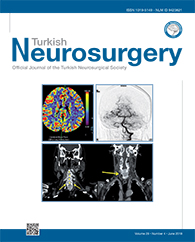2Capital Medical University, Beijing Neurosurgical Institute, Center of Brain Tumor, Beijing Institute for Brain Disorders, Beijing, China
3Capital Medical University, Beijing Tiantan Hospital, Department of Neurosurgery, Beijing, China DOI : 10.5137/1019-5149.JTN.20760-17.1 AIM: To explore the possible invasive effect of four microRNAs (miRNAs) in invasive pituitary adenomas.
MATERIAL and METHODS: Based on our previous studies, several in silico algorithms, and relative literature, 30 Han Chinese patients with invasive pituitary adenomas and 30 with non-invasive pituitary adenomas were involved in this research. The proteins related to invasion underwent immunohistochemical staining, including basic fibroblast growth factor (FGF2), pituitary tumor transforming gene (PTTG), cyclin B1 (CCNB1), survivin, focal adhesion kinase (FAK), and microvessel density (MVD). To validate the effect of miRNAs, miR-24, miR-93, miR-126, and miR-34a were chosen as possible targets for the aforementioned proteins with four in silico algorithms. All miRNAs tests were performed using quantitative real-time polymerase chain reaction (qPCR). The expression levels of proteins and miRNAs associated with tumors" invasiveness were analyzed.
RESULTS: In our study, FGF2, FAK, PTTG, CCNB1, and MVD were overexpressed in the invasive group compared with the noninvasive group, while an increase in the expression of survivin in the invasive group did not achieve statistical significance. This paper reviewed the literature, and four miRNAs involving invasion were selected for study: miR-24, miR-34a, miR-93, and miR-126. Under-expression of miR-24, miR-34a, and miR-93 was significant in the invasive group, while a decrease of miR-126 expression in the invasive group did not achieve statistical significance.
CONCLUSION: FGF2, PTTG, CCNB1, survivin, FAK, and MVD proteins of pituitary adenoma showed strong expression in invasive tumors. Furthermore, miR-24, miR-93, miR-34a, and miR-126 were under-expressed in invasive Pituitary adenomas compared with non-invasive ones. The results indicated some relationship between the miRNA and protein expression during the pituitary invasion process.
Keywords : Invasive, microRNA, Non-invasive, Pituitary adenoma




